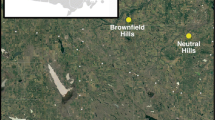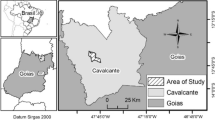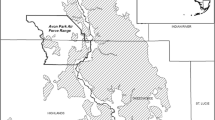Abstract
Fire-maintained, species-rich pine-wiregrass savannas in the Green Swamp, North Carolina were sampled over their natural range of environmental conditions and fire frequencies. Species composition, species richness, diversity (Exp H′, 1/C), and aboveground production were documented and fertilization experiments conducted to assess possible mechanisms for the maintenance of high species diversity in these communities.
Although savanna composition varies continuously, DECORANA ordination and TWINSPAN classification of 21 sites facilitated recognition of 3 community types: dry, mesic, and wet savannas. These savannas are remarkably species-rich with up to 42 species/0.25 m2 and 84 species/625 m2. Maximum richness occurred on mesic, annually burned sites. Aboveground production, reported as peak standing crop, was only 293 g · m−2 on a frequently burned mesic savanna but was significantly higher (375 g · m−2) on an infrequently burned mesic site. Production values from fertilized high and low fire frequency sites were equivalent. Monthly harvest samples showed that savanna biomass composition by species groups did not vary seasonally, but within groups the relative importance of species showed clear phenological progressions.
The variation in species richness with fire frequency is consistent with non-equilibrium theories of species diversity, while phenological variation in production among similar species and the changing species composition across the moisture gradient suggest the importance of equilibrium processes for maintenance of savanna diversity.
Similar content being viewed by others
References
Abugov, R., 1982. Species diversity and phasing of disturbance. Ecology 63: 289–293.
Alatalo, R. V., 1981. Problems in the measurement of evenness in ecology. Oikos 37: 199–204.
Al-Mufti, M. M., Sydes, C. L., Furness, S. B., Grime, J. P. & Band, S. R., 1977. A quantitative analysis of shoot phenology and dominance in herbaceous vegetation. J. Ecol. 65: 759–791.
Barnes, P. W., Tieszen, L. L. & Ode, D. J., 1983. Distribution, production, and diversity of C3-and C4-dominated communities in a mixed prairie. Can. J. Bot. 61: 741–751.
Bartram, W., 1791. Travels through North and South Carolina, Georgia, East and West Florida, etc., Facsimile ed., Dover Publ., Inc., New York.
Bergh, J. P.van den, 1979. Changes in the composition of mixed populations of grassland species. In: M. J. A. Werger (ed.). The Study of Vegetation, pp. 59–80. Junk, The Hague.
Bowen, H. J. M., 1968. The Flora of Berkshire, Holywell Press, Oxford. 389 pp.
Buol, S. W., 1973. Soils of the Southern States and Puerto Rico. USDA South. Coop. Ser. Bull. 174. 105 pp.
Christensen, N. L., 1977. Fire and soil-plant nutrient relations in a pine-wiregrass savanna on the coastal plain of North Carolina. Oecologia 31: 27–44.
Christensen, N. L., 1979. The xeric sandhill and savanna ecosystems of the southeastern Atlantic Coastal Plain, U.S.A. In: H. Lieth & E. Landolt (eds.). Contributions to the Knowledge of Flora and Vegetation in the Carolinas. Vol. 68, pp. 246–262. Veröff. Geobot. Inst. ETH, Stiftung Rübel, Zürich.
Christensen, N. L., 1981. Fire regimes in southeastern ecosystems. In: H. A. Mooney et al. (eds.). Fire Regimes and Ecosystem Properties, pp. 112–136. USDA For. Ser. Gen. Tech. Rpt. WO-26.
Clapham, A. R., Tutin, T. G. & Warburg, E. F., 1962. Flora of the British Isles, 2nd ed. Cambridge Univ. Press, Cambridge. 1269 pp.
Connell, J. H., 1978. Diversity in tropical rain forests and coral reefs. Science 199: 1302–1310.
Connell, J. H., 1980. Diversity and the coevolution of competitors, or the ghost of competition past. Oikos 35: 131–138.
Eleutarius, L. N. & Jones, S. B., 1969. A floristic and ecological study of pitcher plant bogs in south Mississippi. Rhodora 71: 29–34.
Elliot, S., 1821–1824. A Sketch of the Botany of South-Carolina and Georgia. J. R. Schenk, Charleston, S. C.
Fernald, M. L., 1937. Local plants of the inner coastal plain of southeastern Virginia. III. Phytogeographical considerations. Rhodora 39: 465–491.
Folkerts, G. W., 1982. The Gulf coast pitcher plant bogs. Am. Sci. 70: 260–267.
Gaddy, L. L., 1982. The floristics of three South Carolina pine savannahs. Castanea 47: 393–402.
Gano, L., 1917. A study in physiographic ecology in northern Florida. Bot. Gaz. 63: 337–372.
Gauch, H. G., 1982. Multivariate Analysis in Community Ecology. Cambridge Univ. Press, Cambridge. 298 pp.
Gauch, H. G. & Whittaker, R. H., 1981. Hierarchical classification of community data. J. Ecol. 69: 537–557.
Greene, S. W., 1935. Relation between winter grass fires and cattle grazing in the longleaf pine belt. J. For. 33: 339–341.
Grime, J. P., 1973. Control of species density in herbaceous vegetation. J. Environ. Manage. 1: 151–167.
Grime, J. P., 1979. Plant Strategies and Vegetation Processes. Wiley, New York. 222 pp.
Grubb, P. J., 1977. The maintenance of species-richness in plant communities: the importance of the regeneration niche. Biol. Rev. 52: 107–145.
Harper, R. M., 1906. A phytogeographical sketch of the Altamaha Grit Region of the Coastal Plain of Georgia. Ann. N.Y. Acad. 17: 1–415.
Harper, R. M., 1914. Geography and vegetation of northern Florida. Ann. Rep. Florida State Geol. Surv. 6: 167–451.
Harper, R. M., 1943. Forests of Alabama. Geol. Survey of Alabama Monogr. 10. Univ. of Alabama.
Heyward, F. & Barnette, R. M., 1934. Effect of frequent fires on chemical composition of forest soils in the longleaf pine region. Florida Ag. Expt. Sta. Tech. Bull. 265.
Hill, M. O., 1973. Diversity and evenness: a unifying notation and its consequences. Ecology 54: 427–432.
Hill, M. O., 1979a. DECORANA. Cornell Ecology Program, Cornell Univ., Ithaca, New York.
Hill, M. O., 1979b. TWINSPAN. Cornell Ecology Program, Cornell Univ., Ithaca, New York.
Hill, M. O. & Gauch, H. G., 1980. Detrended correspondence analysis: an improved ordination technique. Vegetatio 42: 47–58.
Huston, M., 1979. A general hypothesis of species diversity. Am. Nat. 113: 81–101.
Itow, S., 1963. Grassland vegetation in uplands of western Honshu, Japan. Part II. Succession and grazing indicators. Jap. J. Bot. 18: 133–167.
Kologiski, R. L., 1977. The phytosociology of the Green Swamp, North Carolina. N.C. Ag. Expt. Sta. Tech. Bull. No. 250. 100 pp.
Lawson, J., 1714. Lawson's history of North Carolina. Garrett and Massie, Inc., Richmond, VA. 259 pp. (2nd ed. printed 1952.)
Lemon, P. C., 1949. Successional responses of herbs in longleafslash pine forest after fire. Ecology 30: 135–145.
Lemon, P. C., 1967. Effects of fire on herbs of the southeastern United States and central Africa. Proc. Tall Timbers Ecol. Conf. 6: 112–127.
Loucks, O. L., 1970. Evolution of diversity, efficiency, and community stability. Am. Zool. 10: 17–25.
Maarel, E. van der, 1971. Plant species diversity in relation to management. In: E. Duffey & A. S. Watt (eds.). The Scientific Management of Animal and Plant Communities for Conservation. Symp. Brit. Ecol. Soc. 11: 45–63.
Maarel, E.van der & Leertouwer, J., 1967. Variation in vegetation and species diversity along a local environmental gradient. Acta Bot. Neerl. 16: 211–221.
Maxwell, H., 1910. The use and abuse of forests by the Virginia Indians. William & Mary Coll. Q. Hist. Mag. 19: 73–103.
Metz, L. J., Lotti, T. & Klawitter, R. A., 1961. Some effects of prescribed burning on Coastal Plain forest soil. USDA For. Ser. Res. Pap. SE-113, Asheville, N.C. 10 pp.
Mueller-Dombois, D., 1977. Comment on Whittaker's paper. In: R. Tüxen (ed.). Vegetation und Fauna, pp. 421–422. J. Cramer, Vaduz.
Nash, G. V., 1895. Notes on some Florida plants. Bull. Torrey Bot. Club 2: 141–161.
Naveh, Z. & Whittaker, R.H., 1979. Measurements and relationships of plant species diversity in Mediterranean shrublands and woodlands. In: F. Grassle, G. P. Patil, W. Smith & C. Taillee (eds.). Ecological Diversity in Theory and Practice, Statistical Ecol. Vol. S6, pp. 219–239. Internat. Coop. Publ. House, Fairland, Md.
Naveh, Z. & Whittaker, R. H., 1980. Structural and floristic diversity of shrublands and woodlands in northern Israel and other Mediterranean areas. Vegetatio 41: 171–190.
Ode, D. J., Tieszen, L. L. & Lerman, J. C., 1980. The seasonal contribution of C3 and C4 plant species to primary production in a mixed prairie. Ecology 61: 1304–1311.
Olsson, H., 1979. Vegetation of the New Jersey pine barrens: a phytosociological classification. In: R. T. T. Forman (ed.). Pine Barrens Ecosystem and Landscape, pp. 245–263. Academic Press, New York.
Paine, R. T., 1966. Food web complexity and species diversity. Am. Nat. 100: 65–75.
Parrot, R. T., 1967. A study of wiregrass (Aristida stricta Michx.) with particular reference to fire. M.A. Thesis, Duke Univ., Durham, N.C. 137 pp.
Peet, R. K., 1974. The measurement of species diversity. Ann. Rev. Ecol. Sys. 5: 285–307.
Peet, R. K., 1978. Forest vegetation of the Colorado Front Range: patterns of species diversity. Vegetatio 37: 65–78.
Peet, R. K., Glenn-Lewin, D. C. & Wolf, J. W., 1983. Prediction of man's impact on plant species diversity. In: W. Holzner, M. J. A. Werger & I. Ikusima (eds.). Man's Impact on Vegetation, pp. 41–54. Junk, The Hague.
Plummer, G. L., 1963. Soils of the pitcher plant habitats in the Georgia coastal plain. Ecology 44: 727–734.
Pullen, T. & Plummer, G. L., 1964. Floristic changes within pitcher plant habitats in Georgia. Rhodora 66: 375–381.
Radford, A. E., Ahles, H. E. & Bell, C. R., 1968. Manual of the Vascular Flora of the Carolinas. Univ. N. C. Press, Chapel Hill. 1183 pp.
Regnéll, G., 1980. A numerical study of successions in an abandoned, damp calcareous meadow in South Sweden. Vegetatio 43: 123–130.
Rights, D. L., 1947. The American Indian in North Carolina. Duke Univ. Press, Durham, N.C.
Roberts, P. R. & Oosting, H. J., 1958. Responses of Venus' flytrap (Dionaea muscipula) to factors involved in its endemism. Ecol. Monogr. 28: 193–218.
Rorison, I. H., 1971. The use of nutrients in the control of the floristic composition of grassland. In: E. Duffey & A. S. Watt (eds.). The Scientific Management of Animal and Plant Communities for Conservation. Symp. Brit. Ecol. Soc. 11: 65–78.
Rosén, E. & Sjögren, E., 1973. Sheep grazing and changes of vegetation on the limestone heath of Öland. Zoon, suppl. 1: 137–151.
Schoener, T. W., 1974. Resource partitioning in ecological communities. Science 185: 27–39.
Schoener, T. W., 1982. The controversy over interspecific competition. Am. Sci. 70: 587–595.
Shmida, A. & Ellner, S. P., 1984. Coexistence of plant species with similar niches. Vegetatio (in press).
Sjögren, E., 1971. The influence of sheep grazing on limestone heath vegetation on the Baltic island of Öland. In: E. Duffey & A. S. Watt (eds.). The Scientific Management of Animal and Plant Communities for Conservation. Symp. Brit. Ecol. Soc. 11: 487–495.
Snyder, J. R., 1980. Analysis of coastal plain vegetation, Croatan National Forest, North Carolina. In: H. Lieth & E. Landolt (eds.). Contributions to the Knowledge of Flora and Vegetation in the Carolinas, Vol. 69, pp. 40–113. Veröff. Gebot. Inst. ETH, Stiftung, Rübel, Zürich.
Stoddard, H. L., 1931. The Bobwhite Quail, Its Habits, Preservation and Increase. Charles Scribner's Sons, New York.
Streng, D. R. & Harcombe, P. A., 1982. Why don't Texas savannas grow up to forest? Am. Mid. Nat. 108: 278–294.
Terborgh, J., 1973. On the notion of favorableness in plant ecology. Am. Nat. 107: 481–501.
Thalen, D. C. P., 1971. Variation in some saltmarsh and dune vegetations in the Netherlands with special reference to gradient situations. Acta Bot. Neerl. 20: 327–342.
Thorne, R. F., 1954. The vascular plants of southwestern Georgia. Am. Mid. Nat. 52: 257–327.
Tilman, D., 1982. Resource Competition and Community Structure. Princeton Monogr. Pop. Biol. 17, Princeton Univ. Press, Princeton, New Jersey. 296 pp.
U.S. Dept. Commerce, National Oceanic and Atmospheric Adm., 1977–83. Climatological Data North Carolina, Vol. 82–88. National Climatic Data Center, Asheville, N.C.
Vogl, R. J., 1973. Fire in the southeastern grasslands. Tall Timbers Fire Ecol. Conf. Proc. 12: 175–198.
Ward, T., 1979. Memo to Thomas Massengale, North Carolina Nature Conservancy, Chapel Hill, N.C. April 13, 1979.
Wells, B. W., 1928. Plant communities of the coastal plain of North Carolina and their successional relations. Ecology 9: 230–242.
Wells, B. W., 1932. The Natural Gardens of North Carolina. Univ. of N.C. Press, Chapel Hill. 458 pp.
Wells, B. W. & Shunk, I. V., 1928. A southern upland grasssedge bog: an ecological study. N.C. Ag. Expt. Sta. Tech. Bull. 32.
Wells, B. W. & Shunk, I. V., 1931. The vegetation and habitat factors of the coarser sands of the North Carolina coastal plain: an ecological study. Ecol. Monogr. 1: 465–520.
Wells, B. W. & Whitford, L. A., 1976. History of stream-head swamp forests, pocosins, and savannahs in the southeast. J. Elisha Mitchell Sci. Soc. 92: 148–150.
Wharton, C. H., 1978. The Natural Environments of Georgia. Off. of Planning and Res., Ga. Dept. Natl. Resources, Atlanta. 227 pp.
Whittaker, R. H., 1977a. Evolution of species diversity in land communities. In: M. K. Hecht, W. C. Steere & B. Wallace (eds.). Evolutionary Biology, Vol. 10, pp. 1–67. Plenum Publ. Corp., New York.
Whittaker, R. H., 1977b. Animal effects on plant species diversity. In: R. Tüxen (ed.). Vegetation und Fauna, pp. 409–425. J. Cramer, Vaduz.
Whittaker, R. H. & Gauch, H. G., 1973. Evaluation of ordination techniques. In: R. H. Whittaker (ed.). Ordination and Classification of Communities, Hndbk. of Veg. Sci. 5, pp. 287–321. Junk, The Hague.
Willems, J. H., 1980. Observations on north-west European limestone grassland and communities. Proc. K. Ned. Akad. Wet. Series C 83: 279–306.
Williams, G. J. & Markley, J. L., 1973. The photosynthetic pathway type of North American shortgrass prairie species and some ecological implications. Photosynthetica 7: 262–270.
Woodwell, G. M., 1956. Phytosociology of coastal plain wetlands of the Carolinas. M.A. Thesis, Duke Univ., Durham, N.C. 51 pp.
Author information
Authors and Affiliations
Additional information
Botanical nomenclature follows Radford, Ahles & Bell (1968). See footnotes to Appendix for details.
We thank the Federal Paper Board Co., Inc. and the North Carolina Nature Conservancy for permission to work on their lands. Support for this work was provided by the National Science Foundation and the University of North Carolina. helpful comments on the manuscript were offered by N. L. Christensen, J. D. Doyle, M. A. Huston & W. H. Schlesinger.
Rights and permissions
About this article
Cite this article
Walker, J., Peet, R.K. Composition and species diversity of pine-wiregrass savannas of the Green Swamp, North Carolina. Vegetatio 55, 163–179 (1984). https://doi.org/10.1007/BF00045019
Accepted:
Issue Date:
DOI: https://doi.org/10.1007/BF00045019




